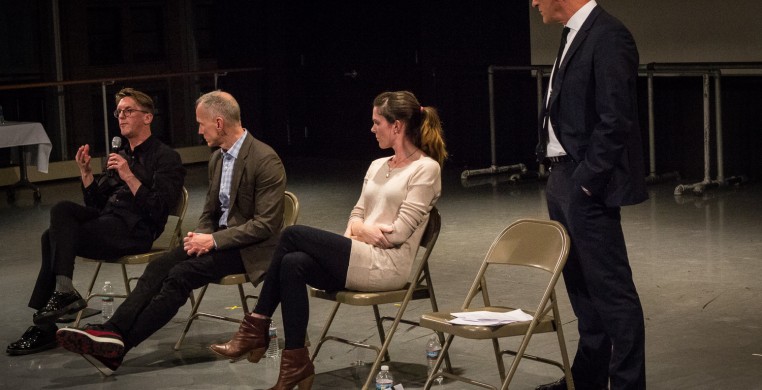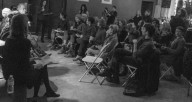December 4, 2014 | Moving Reflections
By Adam j. Greteman, Ph.D.
The bodies sat in the chairs. Some on stage, some in the auditorium. Those on stage looked as if they were uncomfortable sitting. Those in the auditorium the same. Perhaps they were. Perhaps we were all were. After all, we were sitting in a studio at the Joffrey Ballet. The space called out for movement, for an arabesque or a demi-plié...a demonstration of dance for the attending audience. Yet, there would be no dance for the identity of the space shifted that night to the space of ideas and the spaces of history. Bodies were placed in the background. Instead, stories were told about bodies, but only through the memories of bodies that have danced, pushed dance, made dance what it is today. But no bodies danced. The panelists themselves - prolific in their own regard - shifted in their chairs as they engaged questions about the current state of dance within European based and classical dance forms. The body was present, but always secondary to the ideas being presented. How has the identity of dance shifted and how have the identities allowed to be represented in dance shifted, if at all? Shifts happen, of course, but what do they mean in the historical moment in which we find ourselves?
And so the “Moving Dialogue” went as the panelists, consisting of Assistant Professor at the Dance Center of Columbia College, Paige Cunningham, Joffrey Ballet Artistic Director, Ashley Wheater, Hubbard Street Artistic Director, Glenn Edgerton engaged the questions posed by the moderator, Choreographer and former Artistic Director of Kansas City Ballet, William Whitener and the audience.
“What compels an audience to sit in a dark room?” William Whitener asked early on and it seemed a fitting question. Why does an audience choose to spend their time and money sitting in a dark auditorium looking up at a stage of moving bodies? What is compelling about movement - whether it tells a narrative or not - that brings people out and perhaps moves them to tears, to joy, to anger? It is that final possibility, the possibility of being moved emotionally, that was iterated in each of the panelists’ responses. Dance moves the audience through the movement of the dancers. The affective possibilities opened up while watching physical bodies move illuminates our humanity and as Ashley Wheater noted, “encourages us to look at ourselves.” We are embodied. We have bodies. And bodies matter. To look at bodies moving allows us to think about our own bodies in various, complex ways - wishing we had such bodies, feeling shame about our own bodies, remembering bodies we have encountered like those we see...bodies matter and bodies feel.
In an age of 24/7 media consumption, it might seem necessary to ponder the importance of ballet and contemporary dance. While we can watch ballet on-line, the mediated experience loses the sense of scale, the musculature of moving bodies, the drama of live-action. As the camera becomes our ever-moving and ever-roving eye, we lose (while gaining) our own subjective choices in viewing. We do not choose where to look when we watch something framed for us, but in an auditorium, the darkness directs our eyes to the stage, lit up. We, the audience, see the frame and are able to direct our eyes, our “I,” to notice particular things about the movements in front of us. What is it, this movement and what does it tell us? Is it a familiar story we have seen before? Is it an experimental work that disrupts our idea of linear narratives, abstracting the bodies from a story to tell us, show us, something else about our humanity? Is it a classical story retold for contemporary times or a contemporary tale that returns us to a historical moment?
I am not sure; it arguably depends on what piece one is watching and what one brings to such an experience. Does one bring a plethora of experience watching dance growing up within the urban spaces of Chicago or New York, London or Paris? Or is one’s experience with dance through popular films like Fame or Black Swan? Is one type of experience preferred over another in this, oft viewed, elite art form? Does admitting one likes So You Think You Can Dance bring about unrealized scorn from others? Or does such an entry, albeit popular and via TV, bring new audiences to the seats of ballets and contemporary dance performances. Have popular engagements with dance (or might they) help create the desire to be moved by the “real” thing after developing a sense, perhaps of comfort, with this thing called contemporary dance or ballet through their mediated forms? What shifts have happened in access to ballet and contemporary dance? These shifts, it would seem, were ever-present in the discussion as issues of space, such as rural vs. urban, and medium, such as television vs. live, came and went in the discussion as they come and go in this reflection.
As dance shifts from the stage to various screens...the big screen...the television screen...and the screen of smart phones, must it also shift the identities it presents and re-presents? Throughout the discussion the issue of difference emerged, primarily around women, lesbians and gays, and transgender individuals. How has, will, or must ballet and contemporary dance shift its identity to include other identities long absent from their stages? Such issues of gender and sexuality are important, but it is also important to note that issues like race and ability remained hanging in air, untouched. Paige nodded to the whiteness of the panel - a panel of three white males and one white female - noting that it spoke to the state of ballet and the reality it has “a long way to go.” This is less a damning critique. Nor is it surprising. But, it is an opening of possibilities to imagine what might come in dance, in part through what has come already in its history. And such issues have themselves been grappled with in previous “Moving Dialogues” illustrating that identity issues are ever-present in thinking through dance and contemporary ballet in the 21st century.
Ashley Wheater throughout the evening made mention of various shows within the recent history of ballet and contemporary dance that have featured, for instance, male-male pairings or all female casts. Stories of same-sex pairings are not, of course, simply about gay lovers, but have represented a whole host of relational dynamics between men - brothers, friends, fathers and sons. While it seemed the conversations wanted to know about stories about gay lovers - would it be controversial, where are stories that represent gay love - I found Ashley’s seeming refusal to reduce representations of same-sex pairings to sexuality compelling and important. This is not because stories of gay lovers would not be compelling or beautiful, but that same-sex pairings are not absent from the ballet and contemporary dance field. There exist a whole range of relational dynamics that are called upon to illustrate and speak to the complex ways humans relate to or fail to relate to one another. In our current historical moment where gay marriage is ever-present in cultural and political discourse, it makes sense that representations of such stories are yearned for, asked about, perhaps eventually demanded within various realms of art. And shifts are happening, perhaps already have within incubators and experimental spaces. Yet, there is a certain danger, I imagine, in seeking those representations at the detriment of those relational dynamics already present in the archives of dance.
More prescient, perhaps, is the issue of transgender dancers. The question of transgender dancers was brought up a couple of times. And each time it felt like the movement of the conversation misstepped. Classic ideas of gender failed to engage with contemporary gender politics. There was awkwardness around language. Glenn Edgerton sought to start somewhere retelling his own encounter with a parent whose son wanted to wear girl attire and Glenn’s decision to try it. And in trying it to see that in that moment the youth worked through it. It was not an issue for a boy to transgress gendered attire and in doing so disrupt ideas of gender itself. As Glenn noted “children will work it out; it’s the adults that have the limitations.” Yet, while the example Glenn provided was compelling on one hand, an audience member asked if a trans individual could dance professionally. A nice story of a child is great, but what about when the child grows up?
It was perhaps here with issues related to gender, particular transgender individuals, that the two major dance spaces - the professional company and the university - missed one another. How does a dance professor in a university grapple with the shifting student body? How does the setting of a university demand professors be inclusive in their courses, by policy? And how does the professional company - encountering dancers who have made it after years of training - have a different set of standards by which to judge its dancers? Professional companies are still gatekeepers of who gets on stage, while a university program engages those who enroll for a course. While the awkwardness of this conversation led to rather safe statements about the possibility of including trans-bodies, such statements rested on judgments about whether one could dance or not from the professional standpoint. One’s identity doesn’t matter as long as one has the talent. While I want to believe such a sentiment, my skeptic’s body tells me its not that easy. To have been able to dance well at the professional level will have required that many others have allowed and accepted trans individuals to move through the years of training unencumbered by one’s body and the politics of bodies. The trans body - a more and more present body - has yet, it would seem, to matter in dance. Bodies matter. Trans bodies matter. But in the matter of professional dance, bodies are still by and large regulated in particular gendered ways.
The body of course is central to ballet and contemporary dance. While we were sitting, awkwardly, probably, talking about the body we shifted to think about the body on display. And women’s bodies are often on display the most. Paige raised the issue, along with several in the audience about the state of women as dancers and choreographers. Women in dance, both as dancers and as choreographers, are in rather precarious territory. Their bodies are judged for fitness, but their bodies can and often do reproduce. Motherhood entered the conversation as motherhood changes a dancers body, but also changes one’s priorities, so several individuals noted. We might want to believe that women can have it all. Yet, the discussion illustrated that being a mother and a dancer is rather hard on the maternal body, or more so bodies now involved in the relational dynamic between mother and child. Bodies are challenging then. They shift and in shifting different identities emerge. And as identities shift with shifting bodies, so too it would seem does ballet and contemporary dance shift to include new ideas, new stories, new bodies that might matter in the ever-emerging stories of dance.
The issues of shifting identity, to conclude, are age-old questions. Age itself might be a question left unstated as the panelists themselves age in what is often seen as a youthful enterprise. Identities have shifted and will continue to shift. What I think I appreciated most about this rather ‘moving dialogue’ was the attempt to engage such issues - at times through silence or awkwardness - by recognizing the “long way” ballet and contemporary dance have to go, but also how the history of ballet and contemporary dance might already offer inroads in thinking about shifts that have occurred and might there, in the future, occur.
Adam J. Greteman, Ph.D. is an instructor of Art Education at the School of the Art Institute of Chicago. His scholarship focuses on issues of gender and sexuality in education.



